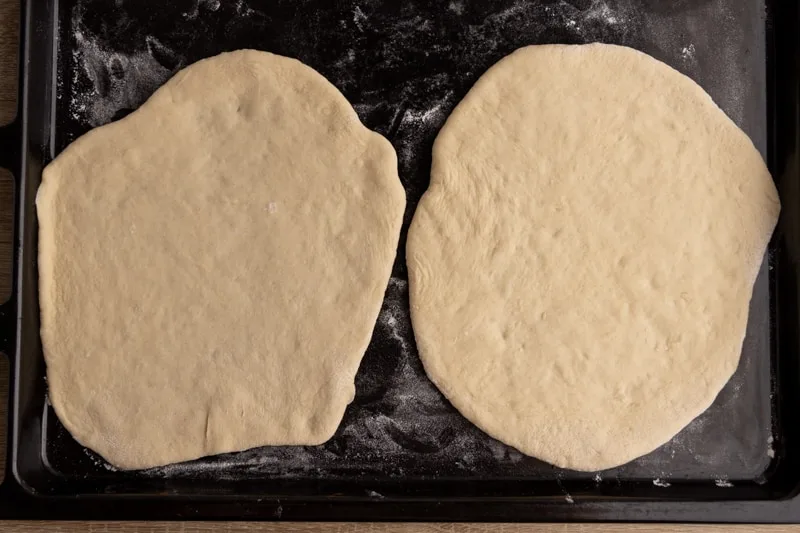Today we’ll cover the shelf life, storage options, and spoilage of pita bread.
Pita bread lasts up to a week if you store it properly. However, similar to bread, it loses its quality quite fast, so the sooner you use yours, the better.
If those 4 to 7 days aren’t enough for you, freezing your leftover pitas is definitely worth considering.
That’s the shelf life of pita bread in a nutshell.
Interesting in learning more about storing pita bread and knowing if yours is spoiled or not?
Let’s get right into it.

Table of Contents
- How Long Does Pita Bread Last?
- How To Store Pita Bread
- How To Tell If Pita Bread Is Bad?
- How To Reheat Pita Bread
- Pita Bread Shelf Life and Spoilage Summary
How Long Does Pita Bread Last?
Pita bread keeps the best quality for 3 to 4 days on the counter but usually stays good for up to a week. If you refrigerate it, it lasts between 5 and 7 days.
If those periods aren’t long enough for your needs, you can always freeze the flatbreads.
Homemade vs. Store-Bought
If you’re buying pre-packed pita bread, assume that the flatbreads should keep quality up to the printed date and maybe a couple of days past it. That’s about all you can get from it.
Once you open the package, try to use all the pitas within 3 to 4 days or freeze the leftovers.
For homemade pita bread, most recipes come with a shelf life of 3 to 4 days, and that’s about as long as those flatbreads keep decent quality. Once again, you can freeze them if you made too much or made a bug bunch in advance.
Going Stale
Like regular bread, pita bread goes stale sooner or later. When exactly that happens depends on the recipe and storage conditions.
Of course, you can still eat stale pita bread, and if you fill the pockets with some delicious food, the dish will still taste quite good. Probably not ideal, but good enough if you’re hungry and looking for a quick bite to eat.
Long story short, the sooner you get to your pitas, the better quality you get.
And if you need more time than a few days, or you don’t want to worry about eating your leftovers before they dry out and harden, freezing is a great solution.
The flatbreads freeze well, and I wrote a guide on freezing pita bread on our sister site CanYouFreezeThis.com. It’s a must-read if you’re interested in freezing your pitas.

How To Store Pita Bread
You can store pita bread at room temperature or in the fridge.
When on the counter, allow it to breathe by placing it in a bread box, paper bag, or linen sack. If you refrigerate it, seal it tight in a freezer bag, so it doesn’t dry out.
In other words, anything that works great for storing regular bread works for pita flatbreads too.
Now, let’s talk about both storage options in more detail.
On the Counter
When storing pita breads at room temperature, the safest option is to allow them some airflow, but not too much.
The bread needs the ability to get rid of any excess moisture that it doesn’t need, but if it’s completely uncovered, it’s going to dry out fast.
(That’s why bread boxes and paper bags work well and why bread-like foods are often sold in paper bags.)
The main downside of allowing airflow is that pitas gradually dry out. That’s why your bread is stale after a couple of days, and the same thing happens to pita bread.
The solution to that is storing pitas in zip-top bags, which many food bloggers recommend. Such bags trap all the moisture inside, keeping the pitas from drying out too soon.
That helps the flatbreads retain quality for a couple of days longer, but it’s not all sunshine and rainbows. The issue here is that, at room temperature, excess moisture that cannot escape is a recipe for mold growth.
(And your pitas don’t need to be particularly moist. If the storage temperature is high enough, some water will evaporate from the flatbreads and condensate on the surface of the bag.)
Long story short, using bags helps pitas keep quality but is risky, especially if you leave the flatbreads at relatively warm temperatures.
If you decide to store your pitas in a resealable bag, squeeze out all the air before sealing it and make sure the flatbreads are nice and cool so that they won’t start to sweat and produce water drops on the surface.

In the Fridge
You can store pita bread in the fridge as long as you seal it tightly, preferably in a freezer bag. If you don’t, the flatbread will dry out within a couple of days.
As with storing pita breads in a bag on the counter, remember to squeeze out the air from the bag and ensure the flatbreads are cool before they get in the refrigerator.
Last, you might have read people reporting that refrigeration has made their pita breads completely dry in a day or two. That’s quite normal if you refrigerate food that’s not covered properly.
For me, the ideal way to handle pita bread is to use as many flatbreads as I need when they’re fresh and freeze the rest. The same works for naan bread.
Notice Patterns
If you’re buying or cooking pita bread on at least a semi-regular basis, try to notice patterns and change your practices based on the results you get.
For instance, say you buy pitas in a plastic bag, and they sometimes grow mold even before you open them up. That probably means there’s some condensation going in that bag that you need to deal with.
One option is to poke some holes in the bag to allow the flatbreads to breathe and humidity to escape. Or to repack the pitas to a paper bag, which accomplishes the same thing.
Alternatively, you can store those pitas in the fridge and see if that resolves the issue.
Or maybe your pita breads go stale after two days.
If that’s the case, try going with a zip-top bag at room temperature, or move them to the fridge. Either might help with your issue, but you’ll only know once you test it.
Long story short, tinker with how you store pita breads until you find a winning formula.

How To Tell If Pita Bread Is Bad?
Discard pita bread if it’s moldy. If you notice any fuzzy action on the surface of a flatbread, toss it.
If you store pita breads sealed tightly on the counter, they can grow mold if there’s excess moisture that would like to evaporate but can’t. Humidity plus room temperature equals mold growth.
Mold growth isn’t all that common, and what’s more likely to happen is that your pitas will dry out and become stale if stored for too long.
When it comes to staleness and at what point you should throw out a stale pita, it’s up to you.
If you find it too dry to use, you can toss it for quality purposes. Or you can try to revive it (more on that in the next section), stuff it with some delicious foods, and eat it. It’ll probably be quite alright.
Another option is to use it in a different way.
For instance, you can make breadcrumbs out of stale pita bread. You grind it down, bake it until lightly toasted, let it cool, and voila, you have homemade breadcrumbs.
(Here’s a good article on how to do that step by step if you’re interested.)
Or you can make pita bread pudding. Bread pudding doesn’t last long, but it’s a great use of stale pitas that you probably haven’t thought of.

How To Reheat Pita Bread
Reheated pita bread tastes better than a room-temperature one. That’s why many people warm up pitas before stuffing them, especially if whatever they are using as a filling is warm too.
The quickest and easiest ways to reheat pita bread are:
- Non-stick skillet on the stove. All you need is a hot skillet and 1 to 2 minutes per side. No oil or any other fat is needed.
- In the microwave. Nuke the pitas on full power in 20- to 30- second increments. If they start to dry out, switch to half power and up the time of each microwaving session to 50 – 60 seconds.
Besides reheating, another way to enhance the taste of your pita breads is to make sure they don’t dry out. Or, if they’re already dry, you can try reviving them using a bit of water.
You can do that by giving a source of moisture to the flatbreads when reheating them.
If you’re reheating yours on the stove, try spritzing some water on top or dampen them with wet hands. If you’re microwaving them, wrap each pita with a damp (not wet) paper towel.
Both methods should help you revive a stale pita, but don’t expect miracles. A stale pita is still a stale pita.
Similar reheating methods work for other flatbreads, including tortillas.
Pita Bread Shelf Life and Spoilage Summary
Thanks for reading this primer on pita bread. Here are the takeaways:
- Pita bread keeps top quality for 3 to 4 days on the counter, but it typically lasts for up to a week before it’s completely stale. You can also store pitas in the fridge, as long as you keep them sealed tightly in a freezer bag.
- You can store pita breads on the counter or in the fridge. If you leave them at room temperature, allow them to breathe so that they don’t trap moisture and grow mold. When refrigerating, seal them tightly so that they don’t dry out.
- If a couple of days of storage isn’t enough for you, or you’re considering cooking a large batch, you can freeze pita bread.
- Throw out pita bread if it grows mold. If it’s stale, you can revive it by spritzing it with some water and warming it in the oven or microwave. Or you can grind it down and make breadcrumbs.